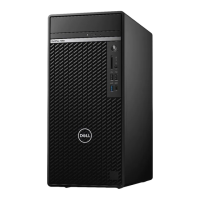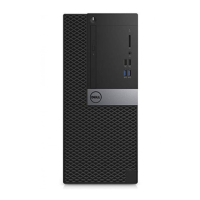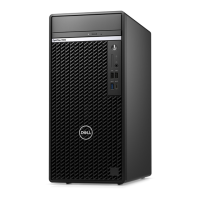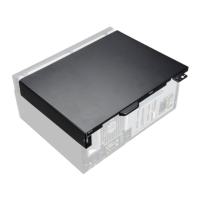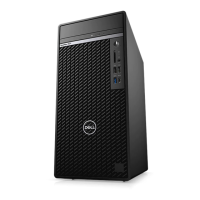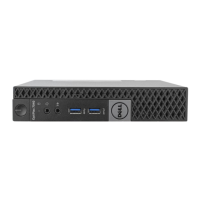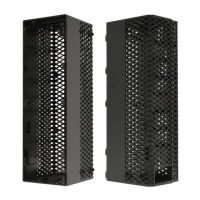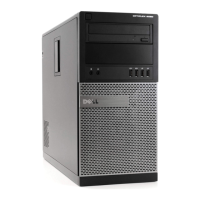What to do if my Dell Desktop has no memory/RAM detected?
- JjamesosborneAug 16, 2025
First, confirm that the memory module is installed properly. If the problem persists, replace the memory module.
What to do if my Dell Desktop has no memory/RAM detected?
First, confirm that the memory module is installed properly. If the problem persists, replace the memory module.
What to do if my Dell Desktop has memory/RAM failure?
Try resetting the memory module. If the problem continues, replace the memory module.
How to fix CPU failure on Dell Desktop?
Run the Dell Support Assist/Dell Diagnostics tool. If the problem persists after running the diagnostic tool, consider replacing the system board.
What to do if my Dell Desktop has invalid memory installed?
Reset the memory module. If the problem persists, replace the memory module.
What to do if my Dell Desktop has System board failure (included BIOS corruption or ROM error)?
Try flashing the latest BIOS version. If the problem persists, replace the system board.
What to do if my Dell OptiPlex Tower 7010 has BIOS Recovery image not found?
Flash the latest BIOS version. If the problem persists, replace the system board.
What to do if my Dell OptiPlex Tower 7010 has BIOS Recovery image found but invalid?
Flash the latest BIOS version. If the problem persists, replace the system board.
How to fix CMOS battery failure on Dell Desktop?
Reset the CMOS battery connection. If the problem persists, replace the RTS battery.
What to do if my Dell OptiPlex Tower 7010 has Power rail failure?
The EC ran into power sequencing failure. If the problem persists, replace the system board.
What to do if my Dell OptiPlex Tower 7010 has Intel ME (Management Engine) Error?
Timeout waiting on ME to reply to HECI message. If the problem persists, replace the system board.
Illustrates the front view of the OptiPlex Tower 7010 computer, highlighting key components.
Illustrates the rear view of the OptiPlex Tower 7010 computer, highlighting ports and connectors.
Provides dimensions and weight specifications for the OptiPlex Tower 7010.
Details the processors supported by the OptiPlex Tower 7010.
Lists the chipset details supported by the OptiPlex Tower 7010.
Details the operating systems supported by the OptiPlex Tower 7010.
Lists the memory specifications for the OptiPlex Tower 7010.
Lists and describes the external ports available on the OptiPlex Tower 7010.
Lists the internal slots available in the OptiPlex Tower 7010.
Details the wireless local area network (WLAN) module specifications.
Lists the audio specifications for the OptiPlex Tower 7010.
Details the storage options and matrix for the OptiPlex Tower 7010.
Lists the power rating specifications for the OptiPlex Tower 7010.
Details the power supply connector specifications.
Lists specifications for the integrated GPU on the OptiPlex Tower 7010.
Lists specifications for discrete GPUs supported by the OptiPlex Tower 7010.
Details the maximum supported resolution for video ports.
Lists the hardware security features for the OptiPlex Tower 7010.
Details the environmental specifications of the OptiPlex Tower 7010.
Lists the regulatory compliance information for the OptiPlex Tower 7010.
Details the computer's operating and storage environmental specifications.
Provides essential safety guidelines for working inside the computer.
Steps to prepare before performing any internal computer maintenance.
Lists critical safety precautions for disassembly and reassembly procedures.
Describes the method of connecting grounding conductors for ESD safety.
Explains ESD, its impact, and types of ESD damage to components.
Details the components of a typical ESD field service kit.
Steps to complete after performing internal computer maintenance.
Lists screws used for various component removal and installation procedures.
Identifies and illustrates the major components of the OptiPlex Tower 7010.
Procedure for removing and installing the computer's side cover.
Procedure for removing and installing the computer's front bezel.
Procedure for removing and installing a 2.5-inch hard drive assembly.
Procedure for removing and installing a 3.5-inch hard drive assembly.
Procedure for removing and installing the Slim optical drive.
Procedure for removing and installing memory modules (RAM).
Information on removing and installing M.2230 and M.2280 solid-state drives.
Procedure for removing and installing the WLAN card.
Procedure for removing and installing expansion cards like graphics cards.
Procedure for removing and installing the internal speaker.
Procedure for removing and installing the coin-cell battery.
Procedure for removing and installing the intrusion switch.
Procedure for removing and installing the power-supply unit.
Procedure for removing and installing the processor fan and heat-sink assembly.
Procedure for removing and installing the fan duct.
Procedure for removing and installing the processor.
Procedure for removing and installing the computer's power button.
Information on removing and installing internal and external wireless antenna kits.
Procedure for removing and installing the optional external SMA antenna module.
Details on optional modules that can be added to the computer.
Procedure for removing and installing the optional serial module.
Procedure for removing and installing the optional VGA module.
Procedure for removing and installing the optional DisplayPort module.
Procedure for removing and installing the optional HDMI module.
Procedure for removing and installing the system board.
Identifies various connectors on the system board.
Lists the operating systems supported by the OptiPlex Tower 7010.
Guidance on troubleshooting, downloading, and installing drivers.
Steps to access the BIOS setup program on your computer.
Details the keyboard keys used for navigation within the BIOS setup.
How to access the One Time Boot Menu using the F12 key.
Lists and describes various system setup options available in the BIOS.
Configure boot sequence, mode, and secure boot settings.
Enable/disable audio, serial port, USB, and dust filter maintenance.
Configure SATA operation, port enablement, and display settings.
Configure network, wireless, Bluetooth, and power management settings.
Configure TPM, chassis intrusion, data wipe, and system/admin passwords.
Manage BIOS updates, OS recovery, and system management features.
Configure keyboard error detection and pre-boot behavior.
Configure virtualization, CPU performance, and view BIOS event logs.
Step-by-step guide to update the BIOS from within the Windows operating system.
Procedure to update BIOS using a bootable USB drive in Windows.
Steps to update BIOS using the F12 One-Time Boot Menu.
Guides on creating, changing, or deleting system and setup passwords.
Procedure to reset BIOS settings by clearing CMOS.
How to clear system or BIOS passwords by contacting Dell support.
Details and how to run Dell's pre-boot hardware diagnostics.
Procedure to run the PSU's built-in self-test for troubleshooting.
Explains the meaning of system diagnostic LED blinking patterns.
Steps and tools for recovering the operating system using Dell SupportAssist.
Procedure to reset the system's Real Time Clock (RTC).
Information on creating recovery drives and backup options.
Steps to perform a power cycle on Wi-Fi devices to resolve connectivity issues.
Lists Dell's self-help resources like website, apps, and knowledge base.
Information on how to contact Dell for sales, technical support, or service.
Illustrates the front view of the OptiPlex Tower 7010 computer, highlighting key components.
Illustrates the rear view of the OptiPlex Tower 7010 computer, highlighting ports and connectors.
Provides dimensions and weight specifications for the OptiPlex Tower 7010.
Details the processors supported by the OptiPlex Tower 7010.
Lists the chipset details supported by the OptiPlex Tower 7010.
Details the operating systems supported by the OptiPlex Tower 7010.
Lists the memory specifications for the OptiPlex Tower 7010.
Lists and describes the external ports available on the OptiPlex Tower 7010.
Lists the internal slots available in the OptiPlex Tower 7010.
Details the wireless local area network (WLAN) module specifications.
Lists the audio specifications for the OptiPlex Tower 7010.
Details the storage options and matrix for the OptiPlex Tower 7010.
Lists the power rating specifications for the OptiPlex Tower 7010.
Details the power supply connector specifications.
Lists specifications for the integrated GPU on the OptiPlex Tower 7010.
Lists specifications for discrete GPUs supported by the OptiPlex Tower 7010.
Details the maximum supported resolution for video ports.
Lists the hardware security features for the OptiPlex Tower 7010.
Details the environmental specifications of the OptiPlex Tower 7010.
Lists the regulatory compliance information for the OptiPlex Tower 7010.
Details the computer's operating and storage environmental specifications.
Provides essential safety guidelines for working inside the computer.
Steps to prepare before performing any internal computer maintenance.
Lists critical safety precautions for disassembly and reassembly procedures.
Describes the method of connecting grounding conductors for ESD safety.
Explains ESD, its impact, and types of ESD damage to components.
Details the components of a typical ESD field service kit.
Steps to complete after performing internal computer maintenance.
Lists screws used for various component removal and installation procedures.
Identifies and illustrates the major components of the OptiPlex Tower 7010.
Procedure for removing and installing the computer's side cover.
Procedure for removing and installing the computer's front bezel.
Procedure for removing and installing a 2.5-inch hard drive assembly.
Procedure for removing and installing a 3.5-inch hard drive assembly.
Procedure for removing and installing the Slim optical drive.
Procedure for removing and installing memory modules (RAM).
Information on removing and installing M.2230 and M.2280 solid-state drives.
Procedure for removing and installing the WLAN card.
Procedure for removing and installing expansion cards like graphics cards.
Procedure for removing and installing the internal speaker.
Procedure for removing and installing the coin-cell battery.
Procedure for removing and installing the intrusion switch.
Procedure for removing and installing the power-supply unit.
Procedure for removing and installing the processor fan and heat-sink assembly.
Procedure for removing and installing the fan duct.
Procedure for removing and installing the processor.
Procedure for removing and installing the computer's power button.
Information on removing and installing internal and external wireless antenna kits.
Procedure for removing and installing the optional external SMA antenna module.
Details on optional modules that can be added to the computer.
Procedure for removing and installing the optional serial module.
Procedure for removing and installing the optional VGA module.
Procedure for removing and installing the optional DisplayPort module.
Procedure for removing and installing the optional HDMI module.
Procedure for removing and installing the system board.
Identifies various connectors on the system board.
Lists the operating systems supported by the OptiPlex Tower 7010.
Guidance on troubleshooting, downloading, and installing drivers.
Steps to access the BIOS setup program on your computer.
Details the keyboard keys used for navigation within the BIOS setup.
How to access the One Time Boot Menu using the F12 key.
Lists and describes various system setup options available in the BIOS.
Configure boot sequence, mode, and secure boot settings.
Enable/disable audio, serial port, USB, and dust filter maintenance.
Configure SATA operation, port enablement, and display settings.
Configure network, wireless, Bluetooth, and power management settings.
Configure TPM, chassis intrusion, data wipe, and system/admin passwords.
Manage BIOS updates, OS recovery, and system management features.
Configure keyboard error detection and pre-boot behavior.
Configure virtualization, CPU performance, and view BIOS event logs.
Step-by-step guide to update the BIOS from within the Windows operating system.
Procedure to update BIOS using a bootable USB drive in Windows.
Steps to update BIOS using the F12 One-Time Boot Menu.
Guides on creating, changing, or deleting system and setup passwords.
Procedure to reset BIOS settings by clearing CMOS.
How to clear system or BIOS passwords by contacting Dell support.
Details and how to run Dell's pre-boot hardware diagnostics.
Procedure to run the PSU's built-in self-test for troubleshooting.
Explains the meaning of system diagnostic LED blinking patterns.
Steps and tools for recovering the operating system using Dell SupportAssist.
Procedure to reset the system's Real Time Clock (RTC).
Information on creating recovery drives and backup options.
Steps to perform a power cycle on Wi-Fi devices to resolve connectivity issues.
Lists Dell's self-help resources like website, apps, and knowledge base.
Information on how to contact Dell for sales, technical support, or service.
| Optical Drive | DVD-ROM, DVD+/-RW |
|---|---|
| Chipset | Intel Q670 |
| Storage Options | HDD, SSD, NVMe SSD |
| Graphics | Intel UHD Graphics |
| Ports | HDMI, VGA, RJ-45, Audio, Serial, PS/2 |
| Operating System | Ubuntu |
| Audio | Integrated High Definition Audio with Internal Speaker |
| Networking | Gigabit Ethernet, optional Wi-Fi |
| Slots | PCIe |
| Processor Options | Intel Pentium, Intel Celeron |
| Memory | Up to 128GB DDR5 |

